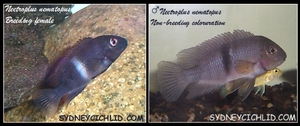Neetroplus nematopus
| Neetroplus nematopus | ||||||||||||
|---|---|---|---|---|---|---|---|---|---|---|---|---|

Neetroplus nematopus , left in brood color, right normal color |
||||||||||||
| Systematics | ||||||||||||
|
||||||||||||
| Scientific name of the genus | ||||||||||||
| Neetroplus | ||||||||||||
| Günther , 1867 | ||||||||||||
| Scientific name of the species | ||||||||||||
| Neetroplus nematopus | ||||||||||||
| Günther, 1867 |
Neetroplus nematopus ( Syn. : Hypsophrys nematopus ) is a freshwater fish from the family of cichlids , which in Central America (Nicaragua and Costa Rica) in Managua , in Nicaragua , in Xiloásee , in Río San Juan opens as well as others in the Caribbean Nicaraguan rivers occurs .
features
Male Neetroplus nematopus reach a length of 14 cm, females remain slightly smaller. They are colored ocher to light brown. On the sides of the body in front of the anal fin there is a dark transverse ligament and 6 to 7 additional, often poorly visible, transverse ligaments. The fins are greyish and translucent, the dorsal and anal fins are often lined with red. During brood care, both sexes turn the other way round, turn dark gray to black and the central transverse band turns white or yellowish. The tips of the pelvic fins can be white, and a white spot can appear at the base of the caudal fin. Adult males of the lake populations have a distinct forehead hump, while this only remains small in the males living in rivers or is not developed at all.
- Fins formula : Dorsal XVIII – IXX / 9–10, Anals VII – VIII / 6–7.
- Scale formula : mLR 34, SL 32–33.
The jaw and tooth morphology, which is adapted to graze on algae and other growth, is characteristic of the species. The lower jaw is very small, the jaws short, the upper and lower jaws being the same length or the lower jaw can be shorter. The teeth are blunt and resemble incisors. They are flattened on the labiolingual (lip and tongue side). The lower jaw teeth are perpendicular to the body axis. The pharyngeal teeth are narrow and blade-shaped, the rear ones have two points.
Way of life
Neetroplus nematopus lives in lakes, medium-sized and larger rivers and is strongly bound to regions with rocks and scree. In rivers, the fish prefer sections with stronger currents. The fish species feed on thread algae and other growth on rocks and sunken wood, as well as plankton and fish spawn and the like. a. of Atherinella sardina and that of other cichlids. Stomach examinations showed the Neetroplus nematopus in the Xiloásee u. a. Juveniles of the lemon cichlid and Parachromis dovii ate, while adult Parachromis dovii prey on Neetroplus nematopus .
Neetroplus nematopus spawns in caves and crevices, if necessary in empty tins and beer cans. The species reproduces all year round with an accumulation in February and July. The 100 to 150 eggs are brownish and about 2.25 mm in diameter. The fry hatch after about nine days and swim free after about another 13 days. During the breeding season, the fish are territorial and very aggressive. Outside of the breeding season, fertile feeding grounds are temporarily defended from time to time.
Systematics
The species and genus were described in 1867 by the German zoologist Albert Günther . In 2007, the species of the genus was hypsophrys assigned and Neetroplus with hypsophrys synonymised . In April 2016 the genus Neetroplus was revalidated again although it is undisputed that Hypsophrys nicaraguensis and Neetroplus nematopus are sister species . However, the two species differ significantly in their skull and tooth morphology, in their diet, their ecological niche, in their brood color and the assignment of the two species to two genera is therefore more in line with the principles of the classification of the other Central American cichlids.
Individual evidence
- ↑ a b Günther Sterba : Freshwater fish of the world. 2nd Edition. Urania, Leipzig / Jena / Berlin 1990, ISBN 3-332-00109-4 , p. 738.
- ↑ a b c d Rainer Stawikowski and Uwe Werner: The American cichlids. Volume 1, Verlag Eugen Ulmer, 1998, ISBN 978-3-8001-7270-2 , pp. 425-427.
- ↑ a b O. Říčan, L. Piálek, K. Dragová, J. Novák: Diversity and evolution of the Middle American cichlid fishes (Teleostei: Cichlidae) with revised classification. In: Vertebrate Zoology. 66 (1), 2016, pp. 1–102 ( PDF ).
- ↑ P. Chakrabarty, JS Sparks: Relationships of the New World cichlid genus Hypsophrys Agassiz 1859 (Teleostei: Cichlidae), with diagnoses for the genus and its species. In: Zootaxa. No. 1523, 2007, pp. 59-64.
Web links
- Neetroplus nematopus on Fishbase.org (English)